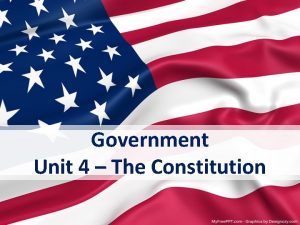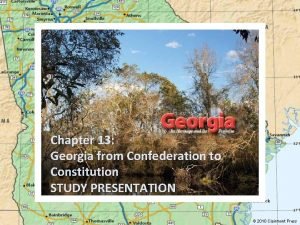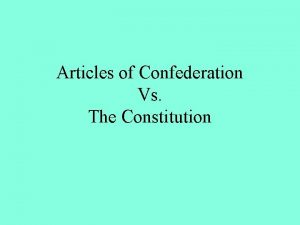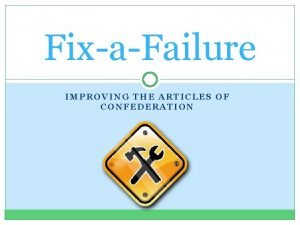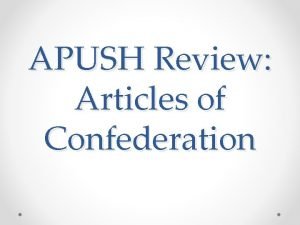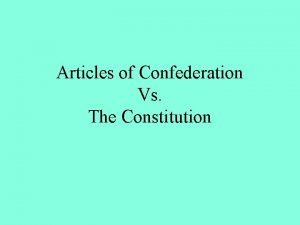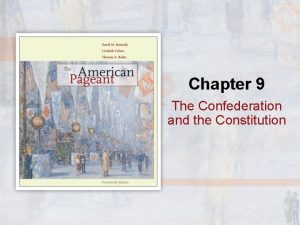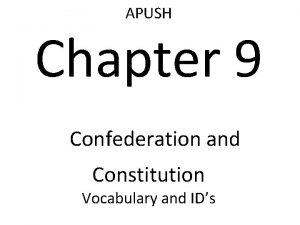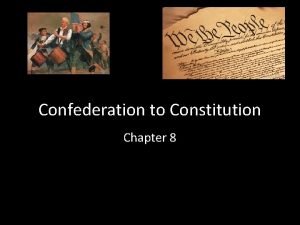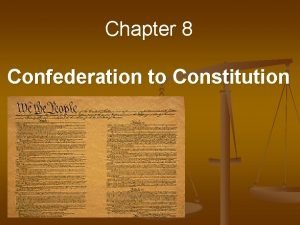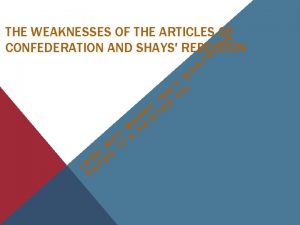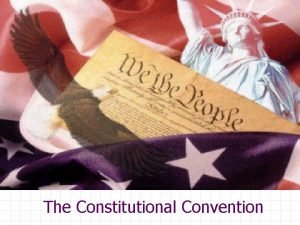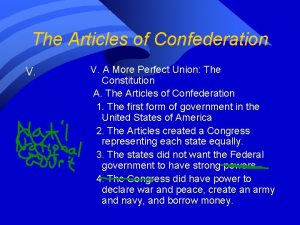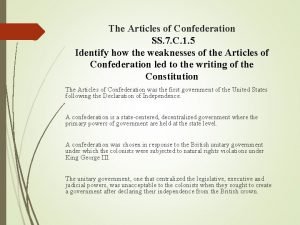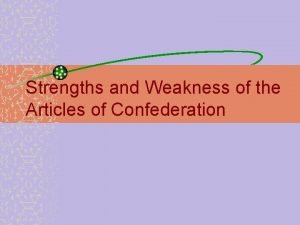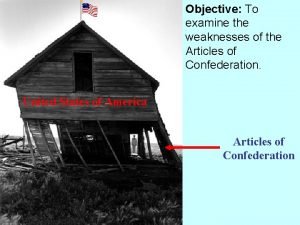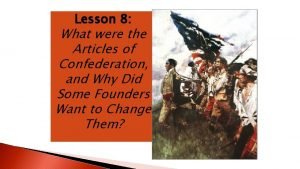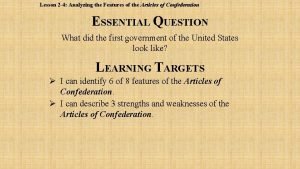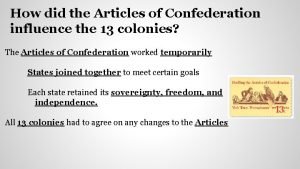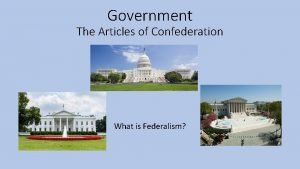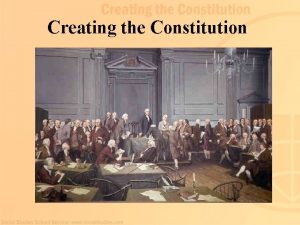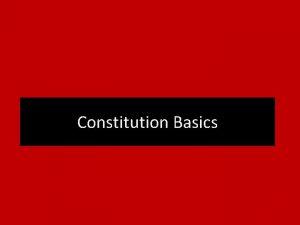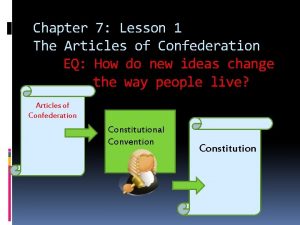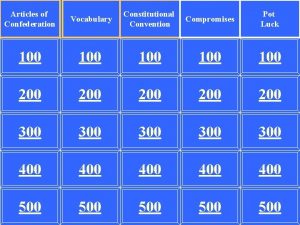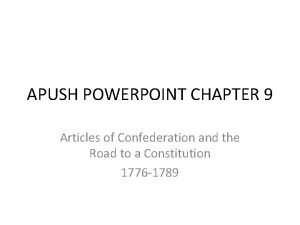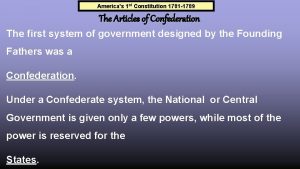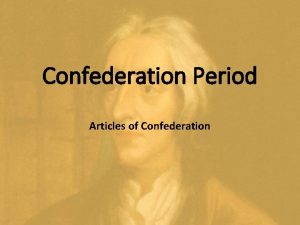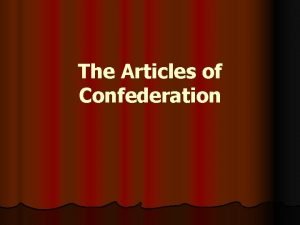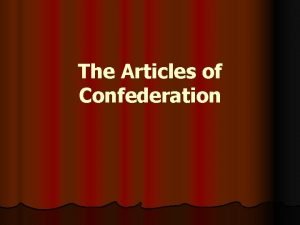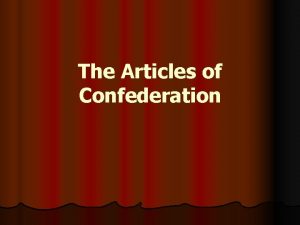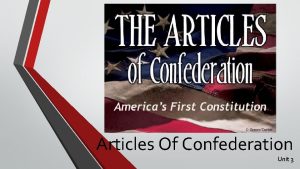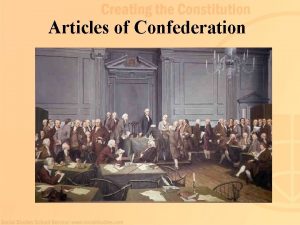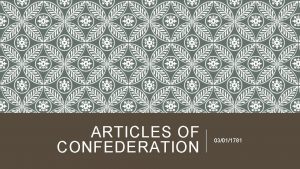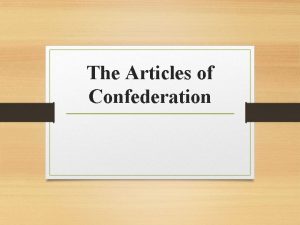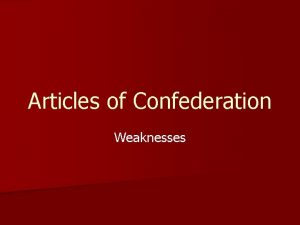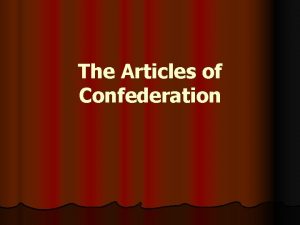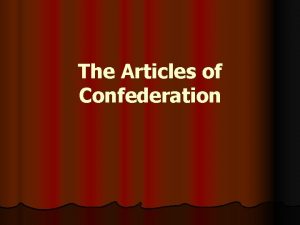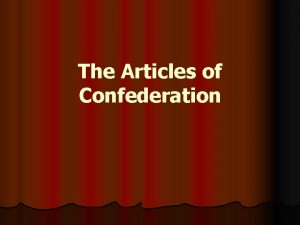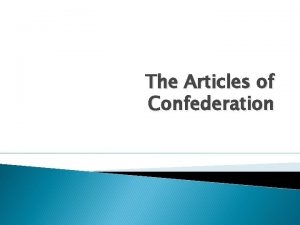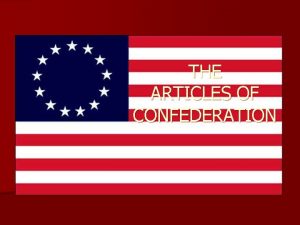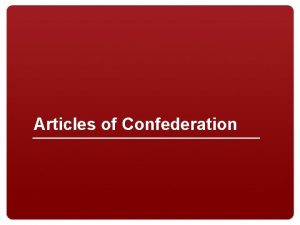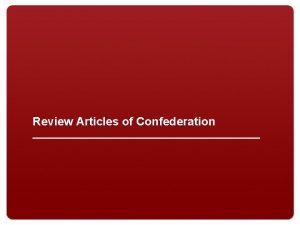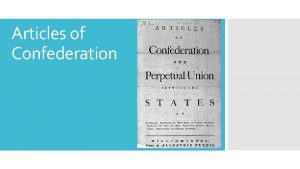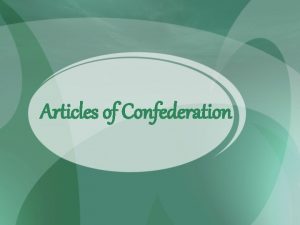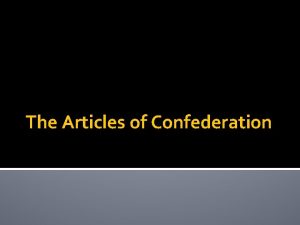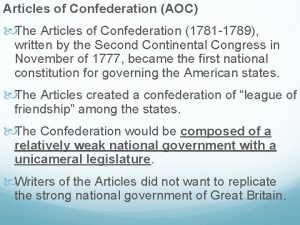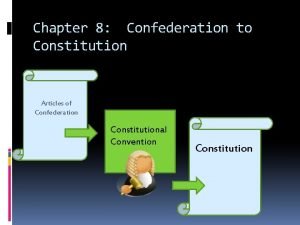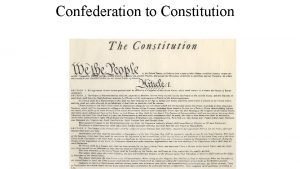The Constitution Articles of Confederation The first written






























- Slides: 30

The Constitution

Articles of Confederation • The first written plan of government for the United States. • Ratified in 1781 • Under this plan a Continental Congress governed and a president acted as the executive officer. • Over time several weaknesses became evident with this plan of government.

Weaknesses in Articles of Confederation • The national government could not force the states to obey its laws. • It did not have the power to tax. • It did not have the power to enforce its laws. • There was no national army or navy. • There was no system of national courts. • Each state could issue its own paper currency. • Each state could put tariffs on trade with other states.

Shays’s Rebellion • Daniel Shays leads a group of farmers in Massachusetts in a rebellion against the state government in 1786. • The farmers attempt to shut down the state courts and seize the state arsenal in Springfield • They were upset with high taxes that put them in debt and led to state courts seizing their property.

Shays’s Rebellion • Massachusetts had to seek assistance in putting down the rebellion. • The national government had no troops to help. • Massachusetts borrowed money to hire an army to put down the rebellion.

Shays’s Rebellion • The inability of Massachusetts to quickly suppress the rebellion and the inability of the national government to provide assistance made many Americans fearful that the new nation was on the brink of collapse. • As a result, a meeting was set to take place in Philadelphia, Pennsylvania in May of 1787 to revise the Articles of Confederation and address the weaknesses that had become evident.

The Constitutional Convention

Constitutional Convention • Meeting began on May 14, 1787. • Meeting held in Philadelphia, Pennsylvania. • 55 delegates from 12 states were present. • Rhode Island did not send a delegation as they did not want to revise the Articles of Confederation. • What began as a meeting to revise the AOC became a meeting to draft a new constitution.

Delegate Demographics • All 55 were white males • Average – 42 • Some were wealthy, most were of moderate means; none were poor • 31 had attended college in a time when higher education was difficult to obtain • 2 were college presidents • 3 were college professors

Delegate Experiences • Most played important roles in the Revolution • Three-quarters served in the Congress under the Articles of Confederation • 8 signed the Declaration of Independence • 5 signed the Articles of Confederation • Many had helped write the constitutions of their states • 7 had served as governors of their states

Key Player – George Washington • 55 at the time; only participated after others convinced him his presence might mean the success of the convention. • As the most revered delegate he was chosen to preside over the convention • He contributed mostly in the informal discussions during the convention.

Key Player – James Madison • 36 at the time of the convention. • Known as the “Father of the U. S. Constitution” due to his many contributions to its writing. • Kept a detailed diary, published 50 years after the ratification that has served as the primary source of constitutional scholarship

Procedures • 7 out of 13 state delegations would constitute a quorum. • Each state got one vote. • A rule of secrecy was adopted. A record was kept and was to be released to the public 30 years after ratification.

Initial Agreement • The delegates to the constitutional convention agreed on a few points early on. • Limited Government • Separation of Powers • Stronger National Government • Limitation of States’ rights to coin money

Great Compromise • Virginia Plan • New Jersey Plan • Bicameral legislature based on either states’ population; Lower house elected by popular vote; Upper house chosen from lists provided by states’ legislatures to lower house • Unicameral legislature with equal representation for each state • Favored by smaller states • Favored by larger states

Great Compromise • Also known as the Connecticut Compromise • Congress will be bicameral • Seats in the lower house (House of Representatives) will be apportioned based on the population of the states’ to be determined in a decennial census (minimum of 1). Members will be popularly elected. • Seats in the upper house (Senate) will be based on equal representation for each state (2) Members will be appointed by states’ legislatures.

3/5 Compromise How might the demographics below lead to a conflict between slaveholding and non-slaveholding states whenever seats in the House of Representatives are apportioned?

3/5 Compromise

3/5 Compromise • North vs. South • North did not feel slaves should count in census since they were not legally free citizens and could not vote. • South argued they were still represented through the votes of their owners. • North argued that if slaves are property they are subject to be taxed. • South did not want slaves to be taxed.

3/5 Compromise • This compromise was introduced on the same day as another compromise dealing with the slavery issue. • In the census all free men would be counted as 1 person. • All other persons (slaves) would be counted as 3/5 of a person. • In other words 5 Slaves = 3 People • This way the south got to pad their representation in the House some while not having to pay taxes on every slave.

Commerce and Slave Trade Compromise • Issues involving trade caused conflict at the Constitutional Convention. • The main issues were the taxation of exports, the regulation of interstate commerce and the slave trade. • Sectional differences appeared on the issue; the North wanted the national government to have greater power to control trade and the South feared the national government would regulate the slave trade out of existence. • The Southern state delegations agreed to allow the national government to have the power to regulate interstate commerce (but no taxing of exports). • The Northern state delegations agreed to ban any government action on slavery for 20 years from the date of ratification.

Key Concepts • Checks and Balances (AOC, State Const. ) • Separation of Powers (State Const. ) • Popular Sovereignty (Locke, Rousseau) • Limited Government (Rousseau) • Judicial Review (Locke) • Federalism

Popular Sovereignty • The power to rule belongs to the people. • “Consent of the governed” • “We the People of the United States …do ordain and establish the Constitution for the United States of America. ”

Limited Government can only do the things the people have given it the power to do. Government and its officials are subject to the law, never above the law.

Separation of Powers

Checks and Balances

Judicial Review An independent judiciary serves as a check on the power of all levels and all branches of government across the nation.

Federalism • Power is shared between levels of government. • Enumerated Powers are those that belong solely to the federal (national) government. • Reserved Powers are those that belong solely to the state governments. • Concurrent Powers are those that are shared between federal and state governments.

Federalists vs. Antifederalists • The Constitution of the United States was approved by the convention and signed by 39 of the delegates on Sept. 17, 1787. • According to Article VII, the Constitution was to be ratified in conventions held in each state. Once 9 states had ratified the Constitution it would become the official plan of government for the United States. • Not all Americans, or all of the delegates to the convention, approved of the final document. This lead to a heated debate across the nation between proponents of the plan and opponents of the plan. • Federalists – supporters of the Constitution. • Antifederalists – opponents of the Constitution.

Federalists vs. Antifederalists • There were several points of contention between these two groups. • Self Interests and Common Welfare • Central Authority and Active Participation • Supremacy Clause and Abuse of Power • Necessary and Proper Clause and Abuse of Power • Individual Liberties • Executive Power
 Articles of confederation vs constitution
Articles of confederation vs constitution Articles of confederation vs constitution
Articles of confederation vs constitution Constitution vs articles of confederation
Constitution vs articles of confederation What are some failures of the articles of confederation?
What are some failures of the articles of confederation? Articles of confederation vs constitution apush
Articles of confederation vs constitution apush Articles of confederation vs constitution chart
Articles of confederation vs constitution chart Chapter 9 the confederation and the constitution
Chapter 9 the confederation and the constitution Chapter 9 confederation and constitution
Chapter 9 confederation and constitution Chapter 8 confederation to constitution
Chapter 8 confederation to constitution Chapter 8 confederation to constitution
Chapter 8 confederation to constitution Political weaknesses of the articles of confederation
Political weaknesses of the articles of confederation Achievements of the articles of confederation
Achievements of the articles of confederation Problems with the articles of confederation
Problems with the articles of confederation Articles of confederation strengths
Articles of confederation strengths Weaknesses of articles of confederation
Weaknesses of articles of confederation Articles of confederation strengths
Articles of confederation strengths Weaknesses of the articles of confederation
Weaknesses of the articles of confederation Strengths of the articles of confederation
Strengths of the articles of confederation Strengths and weaknesses of articles of confederation
Strengths and weaknesses of articles of confederation Failures of the articles of confederation
Failures of the articles of confederation Confederation
Confederation Strengths of the articles of confederation
Strengths of the articles of confederation How did the articles of confederation fail
How did the articles of confederation fail Articles of confederation fail
Articles of confederation fail Federalism in the constitution
Federalism in the constitution Weaknesses of the articles of confederation
Weaknesses of the articles of confederation Chapter 7 lesson 1 answer key
Chapter 7 lesson 1 answer key Articles of confederation vocabulary
Articles of confederation vocabulary Articles of confederation apush
Articles of confederation apush Conventions to ratify constitutions apush
Conventions to ratify constitutions apush What is happening
What is happening
